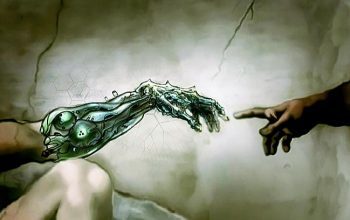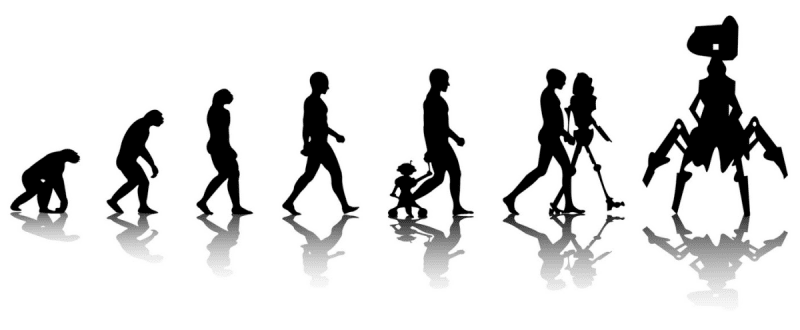June 5th, 2017
Contributing writer for Wake Up World
For anyone who has seen Ex Machina — an independent science fiction psychological thriller — the idea of transhumanism is nothing new. Ava, a humanoid robot, far exceeds expectations of what we normally associate with a machine. She displays an intelligence and adaptability to changing circumstances with the emotional sophistication of a real person — which, in turn, blurs the line between what we consider human and what we consider to be a soulless mechanical imitation. While Ava is a true robot — meaning she doesn’t possess any human material — the film depicted her in a way that was so totally adaptable to human emotions and logic, that it was easy to forget she wasn’t at least part human.
I found the timing with the release of the film in 2015 interesting — largely because, over the last five years or so, we’ve been bombarded with subtle imagery in advertising and the media of people who are half-human, half-machine. Examples can be seen in films like Transcendence, Avatar, Nexus and The Transhumanist Wager. Futurist video game developers, visual artists and techno-musicians have also jumped onto the transhumanist bandwagon in recent years, celebrating the idea of technologically upgraded human beings, who enjoy immortality and are free from all the annoying human maladies that we experience today.
[pro_ad_display_adzone id=”110028″]
Jason Silva, founder of Shots of Awe, is one of the most well-known futurists and has a large following of younger generations. Here’s one of his most popular films, viewed over a quarter of a million times on YouTube. Notice the sweeping, emotional music — as well as the quick moving imagery, which overlays photographs of humans with some form of technology. Silva also speaks with a fast, convincing and confident style.
“To Be Human Is To Be Transhuman”
These transhuman “amalgams” are portrayed as “super-humans” that will solve all our health, psychological and physical problems. Personally, I find the whole sales-pitch and movement towards transhumanism to be exceptionally disturbing. Many, however, suffer no qualms about it. In fact, they are enthusiastic supporters. One such person is Ray Kurzweil, an inventor, futurist and current director of engineering at Google.
A Brave New World of Transhumanism
In just over a three decades, we will be able to upload our entire mind into computers and become digitally immortal — a process classified as “singularity” — according to Kurzweil. He also predicts that biological parts of our body will be completely replaced with mechanical parts as early as 2100.
What exactly is singularity and where did the idea originate?
Journalist Victoria Woollaston explains in the Daily Mail:
Technological singularity is the development of ‘super-intelligence’ brought about through the use of technology.
The first use of the term ‘singularity’ refer to technological minds was by mathematician John von Neumann.
Neumann in the mid-1950s said: ‘ever accelerating progress of technology and changes in the mode of human life, which gives the appearance of approaching some essential singularity in the history of the race beyond which human affairs, as we know them, could not continue.’
The term was then used by science fiction writer Vernor Vinge who believes brain-computer interfaces are causes of the singularity.
Ray Kurzweil cited von Neumann’s use of the term in a foreword to von Neumann’s classic The Computer and the Brain.
Kurzweil predicts the singularity to occur around 2045 while Vinge predicts it will happen before 2030.
In Kurweil’s book, The Singularity Is Near, he explores the journey that is leading us in the direction toward transhumanism. Recent advancements in neural engineering and brain modeling, as well as technologies that replace biological functions, will make it possible.
[pro_ad_display_adzone id=”110030″]
Already we’re seeing examples, like an implant that is attached to the brain’s cochlear nerve and electronically stimulates it to restore hearing to someone who is deaf. Other technologies are being developed that re-establish motor skills after the nervous system has suffered damage. 3D printing is also making strides in creating human body parts, such as the prosthetic ear created at Cornell University.
Kurzweil goes on to say that “we’re going to become increasingly non-biological … [where] the biological part is not important any more.” He adds, “We do need a body, our intelligence is directed towards a body but it doesn’t have to be this frail, biological body that is subject to all kinds of failure modes.”
He believes that we will also have a variety of non-biological bodies in the future.
‘We can create bodies with nano technology, we can create virtual bodies and virtual reality in which the virtual reality will be as realistic as the actual reality. The virtual bodies will be as detailed and convincing as real bodies.
‘But in the future it’s not going to be a little picture in a virtual environment you’re looking at. It will feel like this is your body and you’re in that environment and your body is the virtual body and it can be as realistic as real reality.
‘So we’ll be routinely able to change our bodies very quickly as well as our environments. If we had radical life extension only, we would get profoundly bored and we would run out of things to do and new ideas,’ he said.
Sounds like progress. Or is it?
The Dark Side of Transhumanism
Whenever I hear about a new technology that increases longevity, I have a mixed reaction. On one side, it gives those who are struggling with life-threatening illness hope. But let’s face it, even when we’re in the prime of health, our attena perk up whenever we hear about any discovery that might extend our health and lengthen our lives. On the other side, I feel that all the advancements in medicine over the last hundred years or so have contributed to many of the problems facing humanity today, mainly because of overpopulation. However, when we venture into the realm of transhumanism — which has the potential to extend human life indefinitely — we open a whole new Pandora’s box of ethical questions.
Kyle Munkittrick, Program Director for the Institute for Ethics and Emerging Technologies, gives us some good food for thought to mull over before we race headlong into a transhumanist future:
“Transhumanists are trying to escape aging — and its inevitable symptom, death… Death and aging are why we value children. … I would add it’s also why we value our own life. Moreover, death sweeps away the old and allows the new to emerge.”
Then there is the question of overpopulation. Already there are 6.7 billion of us, “ever-hungry and all want SUV’s and flat screens and will do whatever it takes to man or beast to get them … and are stripping the earth”, according to Munkittrick.
Massimo Pigliucci, Professor of Philosophy at the City University of New York, agrees.
“There are several problems with the pursuit of immortality, one of which is particularly obvious. If we all live (much, much) longer, we all consume more resources and have more children, leading to even more overpopulation and environmental degradation,” he said. “We simply don’t have space, water and other prime materials to feed a forever exponentially increasing population [regardless of the advances in agricultural technology].”
For myself, as someone who has delved deeply into Buddhism for almost two decades, I can’t help but believe transhumanism is nothing more than a way to deny what it means to be human: birth, aging, death. Think about all the time monks around the world meditate on their own death, the fleeting nature of life and the irrefutable truth of change.
From a Western perspective, you would assume this kind of orientation creates a very dour, depressed, “why bother?” kind of person. But it actually does just the opposite. Contemplating these facts of life actually make one more appreciative and aware, while lessening the auto-pilot habit most of us are in each day. Life is treasured as the precious thing it truly is, something to be honored. All the major religious traditions acknowledge the brief nature of physical life and how we should value it accordingly. I, for one, believe they’re onto something.
Maybe the question shouldn’t be how to extend life indefinitely through technological advancement, but rather how do we fully embrace our transient humanity to the fullest.
Article sources:
- www.huffingtonpost.com/zoltan-istvan/transhumanist-art-is-brin_b_5447758.html
- www.nickbostrom.com/ethics/values.html
- www.huffingtonpost.com/2013/06/18/mind-uploading-2045-futurists_n_3458961.html
- www.dailymail.co.uk/sciencetech/article-2344398/Google-futurist-claims-uploading-entire-MINDS-computers-2045-bodies-replaced-machines-90-years.html
- www.ieet.org/index.php/IEET2/more/munkittrick20090702/
- www.science20.com/rationally_speaking/problems_transhumanism
Recommended articles by Carolanne Wright:
- A Tiny House Revolution: Sell Your Crap, Free Your Finances and Live the Good Life for Less
- Renowned Harvard Psychologist Says ADHD is Largely a Fraud
- Hyperbaric Oxygen Treatment Reverses Fibromyalgia in 70% of Patients, Researchers Find
- Wealth and Social Media Breed Narcissism and Lack of Empathy, Says New Research
- Over 100 Scientific Studies Agree: Cannabis Annihilates Cancer
- If You Care About Animals and the Earth, Here’s Why You Need to Boycott Palm Oil Immediately
- Brain Waves and Binaural Beats: A Gateway to Higher Consciousness, Enhanced Learning and Brain Function
- Latest Research on CBD Oil Offers New Hope for Healing Leaky Gut Syndrome and Autoimmune Disorders
- Scientific Breakthrough: Alzheimer’s Ultrasound Therapy Fully Restores Memory Function in Mice
- Why You Should Have a Himalayan Crystal Salt Lamp in Every Room of Your House
- States With Medical Marijuana Laws Have Lower Rates of Opioid-Related Deaths, Study Finds
[pro_ad_display_adzone id=”110025″]
[pro_ad_display_adzone id=”110027″]








